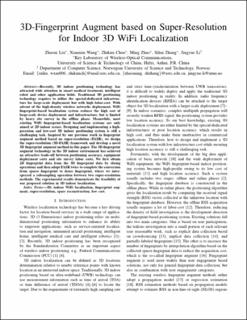3D-Fingerprint Augment based on Super-Resolution for Indoor 3D WiFi Localization
Chapter
Submitted version

Åpne
Permanent lenke
https://hdl.handle.net/11250/2983537Utgivelsesdato
2021Metadata
Vis full innførselSamlinger
Originalversjon
10.1109/WCSP52459.2021.9613334Sammendrag
Recently, 3D indoor positioning technology has attracted wide attention in smart medical treatment, intelligent robot and other application fields. Traditional 3D positioning technology requires to utilize the special-dedicated infrastructure for large-scale deployment but with high labor-cost. With advent of the high-density wireless networks deployment, WiFi fingerprint-based localization system reduces the high cost of large-scale device deployment and infrastructure, but is limited by heavy site survey in the offline phase. Meanwhile, most existing WiFi fingerprint-based localization systems are only aimed at 2D indoor scenes. Designing and implementing a high-precision and low-cost 3D indoor positioning system is still a challenging task. Inspired by our previous work in fingerprint augment method based on super-resolution (FASR), we design the super-resolution (3D-FASR) framework and develop a novel 3D fingerprint augment method in this paper. The 3D-fingerprint augment technology in the 3D indoor environment has achieved an attractive trade-off between positioning accuracy, equipment deployment costs and site survey labor costs, We first obtain 2D fingerprint data from the 3D fingerprint data by slicing operations and then adopt FASR twice to complete the conversion from sparse fingerprint to dense fingerprint, where we interspersed a subsampling operation between two super-resolution methods. The experimental results demonstrate the feasibility of our proposed solution in 3D indoor localization.